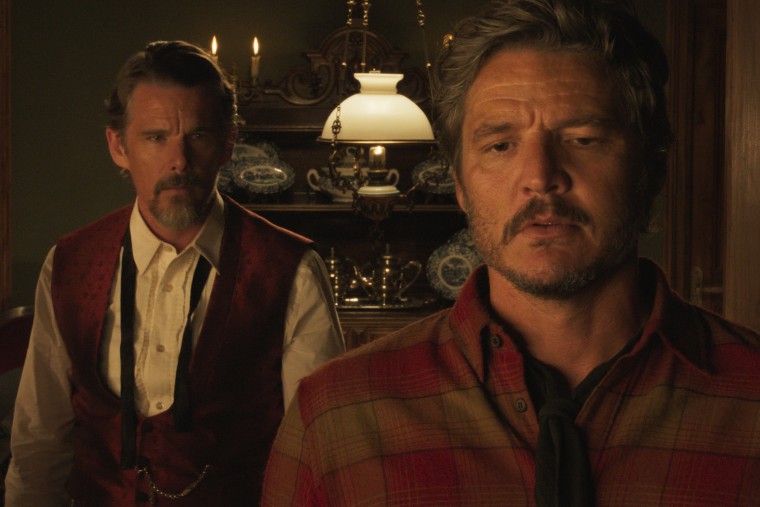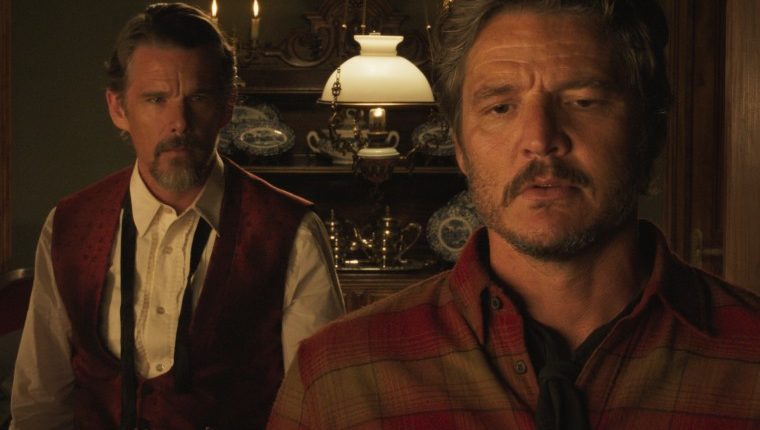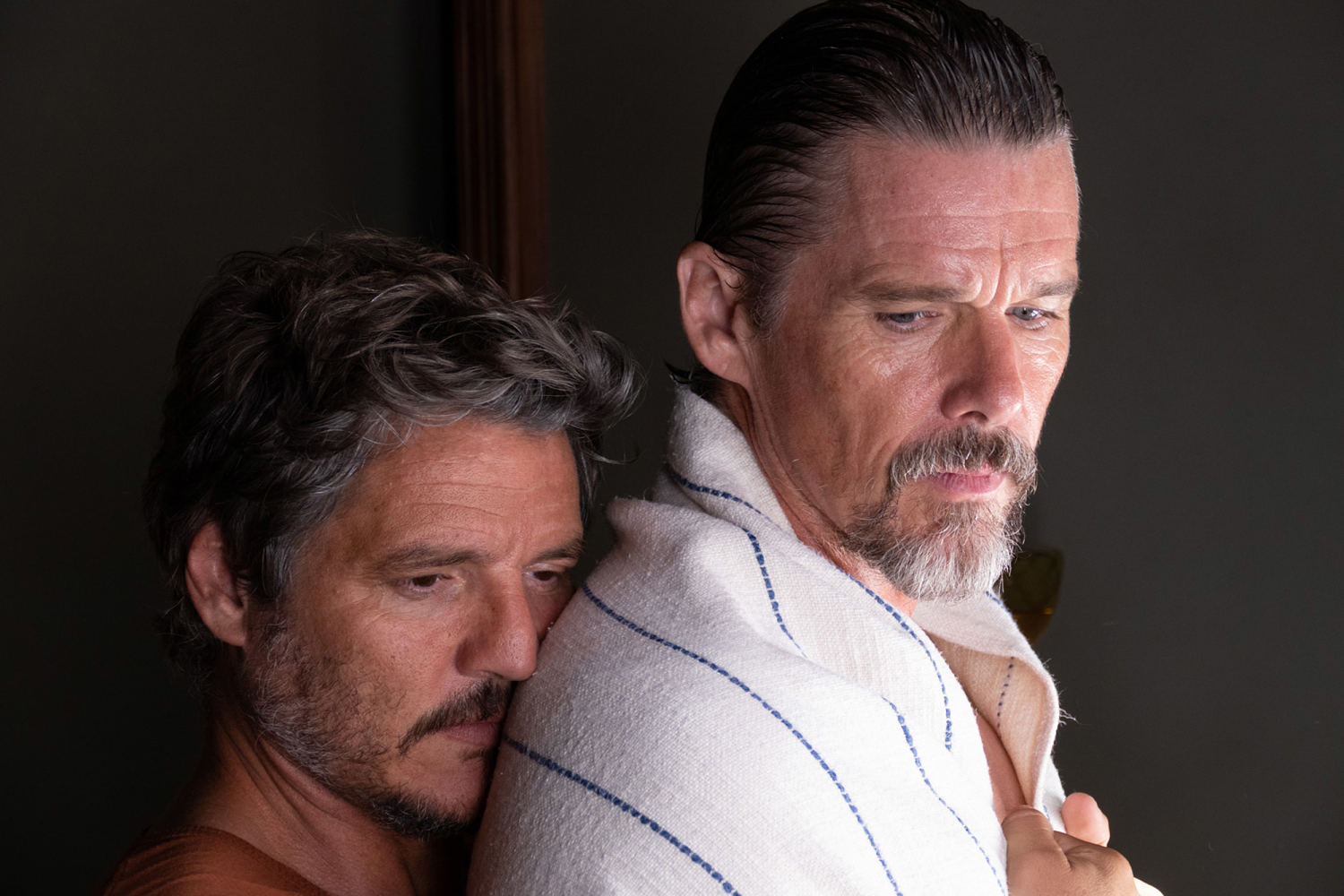“The Western was present in my mind, but I thought that I didn’t have the capacity of writing something like that,” Almodóvar said, adding that he once thought of Westerns as being “very far” from his style. “But, just for pleasure, in the last three years, I started writing a piece that could be a theatrical play about two cowboys after having a night full of sex and alcohol. And that was the beginning.”
In the richly colored short, Pedro Pascal and Ethan Hawke play former lovers whose paths have taken them to opposite ends of the desert and far from the passionate affair of their youth. Jake (Hawke) is now the solitary local sheriff of Bitter Creek, a wind-swept, one-horse town. And Silva (Pascal) lives far away on a ranch with his son, surrounded by dusty hills covered in bright-green desert grass. The two are reunited when Silva unexpectedly shows up at the sheriff’s door with a half-baked excuse, 25 years after a two-month romance that almost turned into more.
The former gunmen put down their pistols and settle in for a cozy catch up, which quickly turns into a booze-fueled night of passion that (mostly) takes place off camera. But when the sun comes up the following day, it exposes more than Silva’s bare buttocks rising out of the crumpled sheets. And the men have to face their unresolved past, as well as being on opposite sides of justice thanks to a murder perpetrated by Silva’s son.
Almodóvar, who grew up in a small town in central Spain, was acquainted with Westerns from a young age. But it wasn’t until moving to Madrid in the late 1960s that he fell in love with the style, through titles from Hollywood legends like John Ford and Howard Hawks, whose Westerns starring John Wayne, James Stewart and Henry Fonda remain the genre’s definitive films.
“When I was a kid, I was not a big fan, because I was living in a small village and they screened a lot of what they call spaghetti Westerns. They were very bad with some exceptions, like Sergio Leone or Sergio Corbucci, but they are the exceptions. The rest were very bad,” Almodóvar said of the European-produced subgenre that was popularized in the ‘60s.
When he moved to Madrid at the age of 18, at a time when Francisco Franco’s dictatorship had essentially closed the city’s one film school, he started educating himself by going to showings at the local theater that carried international and avante-garde films.
“My school — my only school — was to go every day to the cinematheque and start watching all the periods of cinema. And that is when I discovered that it was a major genre — when I discovered ‘The Searchers’ and ‘Red River,’” he said of encountering Ford and Hawks’ Western masterpieces, both of which starred Wayne.
Unlike the spaghetti Westerns of his childhood, these Hollywood epics — along with titles like John Sturges’ “Last Train From Gun Hill” and those from Anthony Mann, who also took Stewart as his muse — captured the budding auteur’s interest. And references to other titles from the 1940s and ‘50s even made their way into some of his most beloved early works, most notably in “Matador,” the 1986 erotic thriller that launched the career of Antonio Banderas, and his 1988 comedic noir, “Women on the Verge of a Nervous Breakdown.” But it’s taken until now for the thoroughly Spanish filmmaker to directly engage with the genre.

While there’s something uniquely playful about “Strange Way of Life,” which the director attributes to the freedom and capriciousness of working in short format, its theatricality makes sense in the context of the Almodóvarian melodrama. But it also feels very true to the classic Western, which features tortured, exaggeratedly masculine protagonists who are either grappling with or blindly driven by their passions — whether that’s a passion for justice or something more base.
The film borrows its title from a fado, or Portuguese folk song, by Amália Rodrigues that “speaks to how strange it is to live your life with your back turned to your desires,” as Almodóvar told the audience in Toronto. And this theme is carried through from the opening scene set to the fado to the protagonist’s relationship and the film’s composition, which often shows the conflicted lovers with their backs turned to the screen or to each other while they discuss their entanglement.
In fact, the composition — which takes on a cheeky double-meaning when the camera regularly lights on Silva’s backside — does most of the work communicating desire, and the men’s tenuous relationship with it. And that, too, is something unique. Though Almodóvar is hardly a stranger to using symbolism, most famously with his signature pops of red, he’s also the director whose 1990 film “Tie Me Up! Tie Me Down!” was instrumental in the adoption of the increasingly contentious NC-17 rating.
“I am becoming more austere with time,” Almodóvar said, only slightly in jest. “At least, I am trying to be more restrained, because it’s something new in my career. I’ve made 22 movies and two shorts, and I made a lot of explicit sexual sequences, so they are not so new for me.”
Rather than restrict or show the physicality between the two men, he added, he wanted to allow the audience to listen to them talk about their desire. “This is more unusual, even, than to show two guys making love,” he said.
The director attributes his more restrained approach to the short’s love scenes — which include a flashback to the protagonist’s younger selves clutching each other under a stream of red wine — to the influence of ‘50 films, and specifically noirs. Despite the stringent censorship on portrayals of sex and sexuality because of the Hays Code, guidelines that sought to police the morality of films and were in place from 1934 to 1968, these titles are the best at talking about desire, Almodóvar said.
“You don’t see explicit physical relations, but the desires are in the eyes of the actors,” he said. “Sometimes, this kind of censorship [emphasizes] what they don’t do.”
The director pointed to the scene after the men’s night of passion, when they circle each other as if in a duel, conjuring the rugged cowboys of Ford and Hawks’ Westerns, while slowly pulling on rough cotton clothes and underwear.
“When they are trying to get dressed, we don’t see their whole bodies,” he said, adding that the audience is imagining the men are completely naked, anyway. “There is a lot of sensuality in these kinds of shots — without nudity.”
Source: | This article originally belongs to Nbcnews.com










